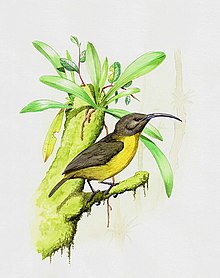Melanocharitidae
| Berrypeckers and longbills | |
|---|---|
 |
|
| Slaty-headed longbill | |
| Scientific classification | |
| Kingdom: | Animalia |
| Phylum: | Chordata |
| Class: | Aves |
| Order: | Passeriformes |
| Suborder: | Passeri |
| Family: |
Melanocharitidae Sibley & Ahlquist, 1985 |
| Genera | |
The Melanocharitidae, the berrypeckers and longbills, is a small bird family restricted to the forests of New Guinea. The family contains ten species in four (sometimes three) genera. They are small songbirds with generally dull plumage but a range of body shapes.
The identification of the family Melanocharitidae was not known or suspected until the work of Sibley and Ahlquist on the taxonomy of birds using DNA–DNA hybridization The genera had been instead placed with other families. The two genera of berrypecker had been placed inside the flowerpecker family Dicaeidae, and the longbills were once considered to be honeyeaters (which they closely resemble). Sibley and Ahlquist placed the berrypeckers and longbill family close to the painted berrypeckers (Paramythiidae), sunbirds and flowerpeckers, but a 2002 study found them closer to the satinbirds (Cnemophilidae, a recent split from the birds-of-paradise).
It comprises ten species in four genera, the Melanocharis berrypeckers and the longbills in the genera Toxorhamphus and Oedistoma. The two longbill genera are sometimes incorrectly lumped into the same genus, Toxorhamphus, in spite of Oedistoma being erected forty years prior to Toxorhamphus (a violation of the taxonomic principal of priority). There are both molecular and morphological reasons to keep the two genera separate, however. A 1993 study of the longbills, berrypeckers and some other aberrant honeyeaters found that the dwarf longbill was more closely related to the berrypeckers than the two longbills in the genus Toxorhamphus. There are also some morphological differences in the shape of the tarsus. The two species in Oedistoma, however, may not be closely related and more research is needed. The spotted berrypecker is placed in its own genus Rhamphocharis, while some treatments lump it with the Melanocharis berrypeckers it is anatomically and behaviourally distinct.
...
Wikipedia
